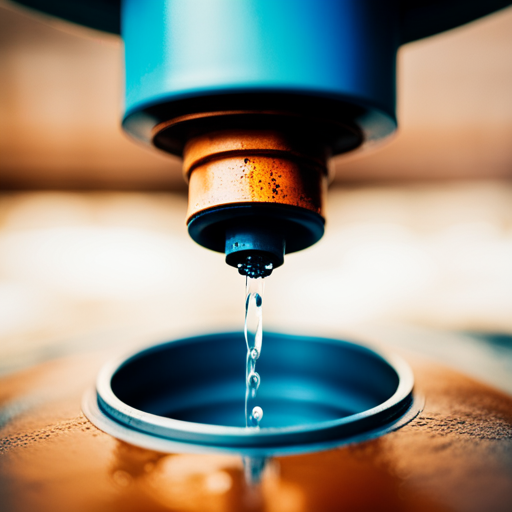Are you tired of dealing with the unpleasant taste and odor of iron in your drinking water? Reverse osmosis might be the solution you’re looking for.
This water treatment method is known for its effectiveness in removing various contaminants, including iron. However, before you invest in a reverse osmosis system, it’s important to understand its pros and cons to determine if it’s the best fit for your needs.
On the one hand, reverse osmosis is highly effective at removing low levels of iron from water. The process involves forcing water through a semi-permeable membrane that filters out impurities, including iron particles. This results in clean, clear water that is free from the unpleasant taste and odor associated with iron.
Additionally, reverse osmosis systems are relatively easy to install and require minimal maintenance. However, it’s important to note that reverse osmosis systems may not be the best option for high concentrations of iron and may require additional maintenance to ensure optimal performance.
In the following sections, we will explore the pros and cons of using reverse osmosis for iron removal and provide helpful tips for choosing the best method for your specific needs.
Key Takeaways
– Reverse osmosis can effectively remove low concentrations of iron from water, but pre-filters are necessary to prevent fouling of the RO membrane.
– High concentrations of iron can foul the RO system and reduce treatment efficiency, making chemical treatment or a berm filter a better option.
– Whole-house filters and point of entry treatment are available options for removing iron from water, but the most effective method will depend on the concentration of iron and other contaminants present.
– It is recommended to have your water tested by a qualified professional to determine the best method for your specific needs.
Effectiveness for Low Levels
If your drinking water has low levels of iron, RO can be an effective method for removing it. RO systems can remove virtually 100% of iron when water passes through the RO membrane. However, it’s important to note that pre-filters may be necessary to prevent the iron from fouling the RO membrane.
Pre-filters can help remove iron before it reaches the RO membrane, which can protect the RO system and prolong its lifespan. Without pre-filters, iron can foul the RO membrane, reducing its effectiveness and increasing maintenance costs. Therefore, it’s recommended to use pre-filters when using RO for iron removal, especially if the levels of iron are high.
Limitations for High Levels
When you have high levels of iron in your drinking water, it can cause issues with fouling and reducing the efficiency of your filtration system, which may result in increased maintenance costs.
Reverse osmosis (RO) isn’t recommended for high concentrations of iron because it can foul the system and reduce treatment efficiency. High levels of iron can also damage the RO membrane, leading to increased maintenance requirements and cost implications.
Chemical treatment or a berm filter may be needed for high levels of iron in your drinking water. These methods can effectively remove iron and other contaminants without damaging the RO membrane or reducing treatment efficiency.
It’s recommended to treat the iron at the point of entry or use a whole-house filter using alternative iron treatment for high concentrations of iron. Overall, while RO can effectively remove low concentrations of iron and manganese, better methods exist for removing iron and hardness from drinking water, especially at high concentrations.
Alternative Iron Treatment Methods
Consider using chemical treatment or a berm filter as alternative methods to remove high levels of iron from your drinking water. Chemical treatment involves the use of chemicals such as chlorine or potassium permanganate to oxidize the iron and then filter it out. This method is effective for high concentrations of iron, but it requires frequent maintenance and can add unwanted chemicals to your water.
On the other hand, a berm filter uses a natural material such as gravel or sand to filter out the iron. This method is low maintenance and does not add chemicals to your water, but it may not be as effective for high concentrations of iron.
When deciding between chemical vs. berm treatment, it is important to consider your specific situation. If you have very high levels of iron, chemical treatment may be the best option. However, if you’re looking for a low-maintenance and natural method, a berm filter may be more suitable.
Additionally, you may want to consider whether you want to treat the iron at the point of entry or use a whole-house filter. A whole-house filter will treat all the water entering your home, while point of entry treatment will only treat the water at a specific faucet or appliance.
Ultimately, the most effective method for removing iron from your water will depend on the concentration of iron and other contaminants present. It’s recommended to have your water tested by a qualified professional to determine the best method for your specific needs.
Conclusion
In conclusion, if you’re dealing with low levels of iron in your drinking water, reverse osmosis can be an effective method for removing it. It’s a popular choice because it can remove a wide range of contaminants in addition to iron.
However, if you have high levels of iron in your water, it may not be the best option. This is because it can require additional maintenance and may not effectively remove all of the iron.
It’s important to consider alternative iron treatment methods if reverse osmosis isn’t the best fit for your specific needs. Some of these methods include oxidation and filtration, ion exchange, and chlorination.
It’s always recommended to consult with a water treatment professional to determine the best method for your individual situation and to ensure the safety and quality of your drinking water.




